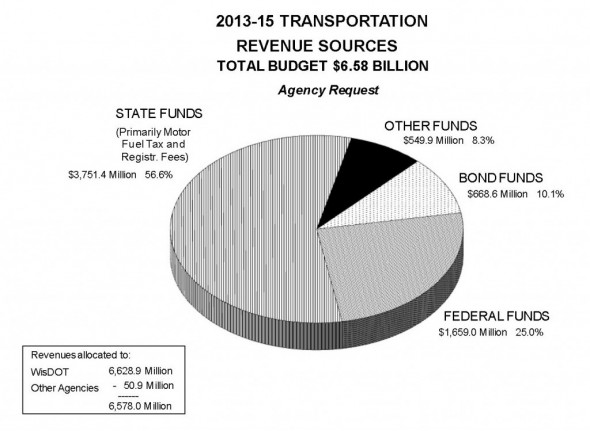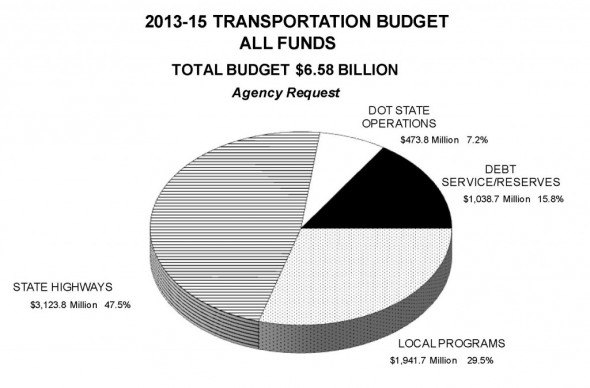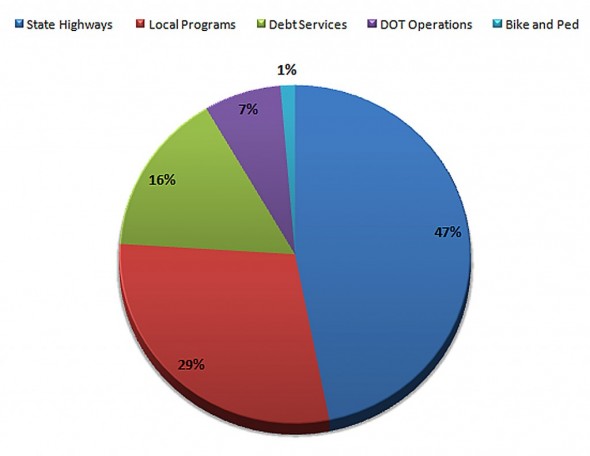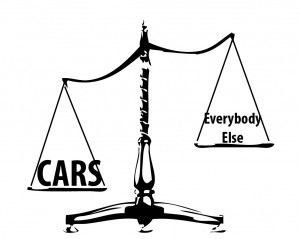A Primer on Transportation Funding
Want to get wonky with me? Here's a rundown of how the government bicycle programs actually work.
In my last blog, I tried to give readers some idea of what kind of funding for bicycle programs might be available in our next state budget. I did my best to put real numbers into a spread sheet that compared what we used to spend, with what is now available from the feds and what the Wisconsin Dept. of Natural Resources and the Dept. of Transportation have in their biennial budget requests for 2013-2015. I also asked the budget folks in each department to look over my numbers to see how accurate they are. I have since heard back that while nothing is final, my numbers are accurate enough for discussion purposes. You can see them in the spreadsheet below:
Before we really get into it, one reader asked that I define some of the terms in the chart above. I hear that request and raise you one. Below I give a comprehensive definition of the most commonly used and misunderstood terms in the world of transportation funding:
| Allocation: | An administrative distribution of funds for programs that (usually) do not have statutory distribution formulas. Allocations usually are for discretionary programs. However, the National Recreational Trails Funding Program allocated funds to the States in FY 1993, 1996, and 1997 by statutory formula. There were no funds in FY 1992, 1994, or 1995. |
|---|---|
| Apportionment: | The distribution of funds as prescribed by a statutory formula. |
| Rescission: | A federal rescission of funds reduces the amount of federal funds provided through previous federal legislation. Rescissions typically target unobligated funds and allow states to choose what programs to cut to meet the rescission. Bike and ped programs are usually rescinded at a much higher rate than highway programs. There were rescissions in FY 2001-2011, but no additional rescissions in 2012. |
| Obligation: | The Federal government’s legal commitment or promise to reimburse the States for the Federal share of a program or project’s eligible costs. |
| Obligational Authority: | The total amount of funds that may be obligated in a year. For the Federal-aid Highway Program this is comprised of the obligation limitation amount plus amounts for programs exempt from the limitation. |
| Obligation Limitation: | A restriction, or “ceiling” on the amount of Federal assistance that may be promised (obligated) during a specified time period. This is a statutory budgetary control that does not affect the apportionment or allocation of funds. Rather, it controls the rate at which these funds may be used. |
| Obligation Rate: | Percent of obligations compared to the amount available (apportioned and allocated) to the State. Wisconsin’s obligation rate for bicycle programs is lower than its obligation authority, which means the State is spending its bicycle funds at a lower rate than allowed by Federal-aid highway program. |
| Programed: | The amount of money the state actually spent for a program in a given year. Sometimes the programmed amount is more or less than the budgeted amount because either planned projects were delayed or old projects finally did get completed. |
| Budgeted: | The amount of money the state plans to make available for a program in a given year. Sometimes the programmed amount is more or less than the budgeted amount because either planned projects were delayed or old projects finally did get completed. |
These terms and definitions are key to understanding how we spend our money, or don’t spend our money on bicycle programs. For instance, Wisconsin’s obligation rate for the Transportation Enhancements program is about 48%, one of the lowest in the nation. That means we have traditionally spent less than half of the money the feds gave us in one of the most important funding programs for bicycle and pedestrian projects. To compound that, our obligation rate after rescissions is 91%, which means when the feds come calling for any unobligated funds to try to balance their books, we give back the bike money at a much higher rate than highway money.
The definitions will also be useful if you are looking at any of the charts that rate or compare how well different states fund bicycle and pedestrian programs. Like this one that compares state spending on Recreational Trails Program, or this one that compares Transportation Enhancement spending.
Feds first
The first thing you need to understand is that virtually all of our money for bicycle programs and projects comes from the federal government. The most recent federal transportation bill is called Moving Ahead for Progress in the 21st Century (MAP-21). MAP-21 is a two-year bill that made quite a few changes to how bicycle programs were funded. You can learn more about those changes in this blog post, but the top-down system in which most bike money comes from the federal government remains unchanged.
In Wisconsin, pretty much the only state dollars spent on cycling comes from our state trail passes, and that only amounts to between $1 million and $1.3 million annually, a proverbial drop in the bucket. You can see in the pie charts below, the amounts are in the thousands of millions of dollars, and our total state transportation budget request is for $6.6 billion.

Source: WisDOT 2013-15 Biennial Budget Highlights Department Budget Request, p. 5

Note the bicycle slice of the pie is so small, the good folks at WisDOT don’t put it in their chart.

Here is a slightly more colorful chart I made that includes all requested bicycle and pedestrian program funds.
As you can see by the more colorful, but depressing, chart I made, bicycle and pedestrian programs only account for about 1.3% of all state transportation dollars. Remember that trips made by biking and walking account for about 12% of all trips taken in Wisconsin and 9% of all fatal crashes. Of those fatal crashes, the majority are the fault of the person behind the wheel of the motor vehicle involved. Given those statistics, why are walking and bicycling getting such a disproportionately tiny piece of the transportation funding pie? And why is our piece 30% smaller this federal budget than last?
If this was a Thanksgiving and I was served that little piece of pie, I’d either think I need to go on a diet or grandma doesn’t love me any more. Given how little money is allocated for bike stuff, it is a wonder we have it as good as we do in Wisconsin. The secret is that bike and ped projects are incredibly inexpensive compared to highway projects and have a much higher return on investment. Consider that Portland, arguably the best major city for bicycling in the country has only spent about $60 million on all their bike projects combined over the last decade. Meanwhile, it is going to cost $350 million to re-deck the 2.2 mile long the Hoan Bridge. So for $60 million, you can buy an international reputation as the best city for cycling in the United States, but $350 million only gets you a new deck on an old bridge most people outside of Milwaukee have never heard of.
 There are a number of reasons finding money for walking and bicycling programs is like squeezing water from a stone. Since the advent of the automobile, traffic engineering programs have been biased in favor of moving motor vehicles rather than people. Then there are the large lobby groups for highways. Recently the most (but not all) TEA Party members have argued that the federal government has no business building facilities for bicycling or walking since those trips are all local or perhaps state at best. Perhaps the biggest reason bike and ped programs are being squeezed is that our transportation infrastructure for motor vehicles has been underfunded for so long, that our roads and bridges are literally falling apart.
There are a number of reasons finding money for walking and bicycling programs is like squeezing water from a stone. Since the advent of the automobile, traffic engineering programs have been biased in favor of moving motor vehicles rather than people. Then there are the large lobby groups for highways. Recently the most (but not all) TEA Party members have argued that the federal government has no business building facilities for bicycling or walking since those trips are all local or perhaps state at best. Perhaps the biggest reason bike and ped programs are being squeezed is that our transportation infrastructure for motor vehicles has been underfunded for so long, that our roads and bridges are literally falling apart.
Despite the hunger for more and wider highways, there is just no appetite for raising gas taxes are the federal or state level. The federal gas tax has not been raised since 1993 and Wisconsin froze our gas tax in 2006. Meanwhile, motor vehicles are getting better fuel economy, people are driving fewer miles and at the same time, the cost of building and maintaining highways keeps getting more expensive. This sort of quadruple wammy has forced the governments to borrow more and cut back on maintenance at the expense of expansion. But don’t take it from me, listen to what Governor Scott Walker’sWisconsin Transportation Finance and Policy Commission has to say about our transportation funding crisis in Wisconsin:
Since 2006 when motor fuel tax indexing was repealed, inflation has reduced the buying power of the state motor fuel tax by nearly 13 percent.
The state’s decision to issue bonds to address the loss of revenues led to debt payments of $762 million in the 2011-13 biennium. Assuming a similar level of bonding over the next 10 years, debt service will consume one-quarter of all state transportation revenues by FY 2023.
In light of the difficulty politicians have raising any taxes these days and their traditional reluctance to tell lobbyists and constituents we can’t afford to maintain the transportation system we have now, let alone increase capacity, everyone from Washington to our town boards are looking for every penny they can cut from politically expendable programs and put those pennies into highways. Guess what, even though every trip involves some walking and about half of the adults in the US ride bikes, we don’t squawk much when we don’t get our fair share of the pie. I guess people who ride bikes and walk a lot just aren’t complainers and the squeaky wheels seem to get the grease.
Had enough? Ready to tap out of the Transportation Alternatives Program (TAP) fight for funds? I think I’ll give it a rest at this point, and wait for questions and comments. Once readers digest this, I will give it another go in a few days and write a post about the Bike Fed’s suggestions for how we might create a more balanced, equitable and sustainably funded transportation system. Until then, I look forward to your comments and I will do my best to answer any further questions.
This story was originally published by the Bicycle Federation of Wisconsin.
Bike Czar
-
Join a Bike Ride Under the Polish Moon
 Jun 1st, 2018 by Dave Schlabowske
Jun 1st, 2018 by Dave Schlabowske
-
9 Reasons to Join National Bike Challenge
 May 4th, 2018 by Dave Schlabowske
May 4th, 2018 by Dave Schlabowske
-
Biking Through the Mindoro Cut
 Apr 27th, 2018 by Dave Schlabowske
Apr 27th, 2018 by Dave Schlabowske





















“In my last blog” … you mean “In my last post” … sorry to be that guy, but important distinction!
Great, clear piece on the ins and outs of the funding recipe and argot. I’ll look forward to the follow-up article on what Bike Fed thinks can/should be done. As a fair-weather rider and all-weather taxpayer, I thank you for your expertise and vigilance.